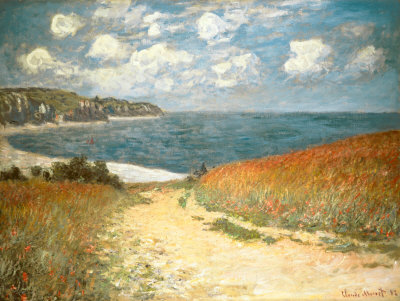Yet the intensity of its clear blue sea was not captured in one of the artist's Mediterranean paintings, Pourville-sur-Mer being a small resort near Dieppe in Northern France. This was a beautiful day in 1882, and by using techniques developed during his time as an impressionist, Monet sought to convey the exhilaration of a day out by the sea.
Firm vertical and horizontal lines lead the eye to the ocean beyond, by way of a curved pathway that slopes down to the beach, and then meanders around the bay at the water's edge until it reaches the horizon. In this way, Monet was able to balance the whole, in what was one of several series executed in the vicinity.
Born in Paris in 1840 but raised near Le Havre in Normandy from the age of 5, Oscar-Claude Monet was a founder member of the French impressionists, revolutionising the use of colour by breaking it down into separate components. He was passionate about its mission to perceive and express nature by working outdoors (en plein air).
He argued that this enabled him to apply his immediate reactions to canvas, and to repeat the same views at different times and under a variety of conditions, presenting an all-round impression. In fact, the term Impressionism was applied to the group for the first time in 1874, after he had completed his painting Impression, Sunrise. The movement suffered rejection from the traditional Académie des Beaux-Arts, prompting them to exhibit independently.
To escape the Franco-Prussian war, Monet travelled with his wife and fellow artists Edouard Manet and Camille Pissarro to London, where he was able to study the output of British painters John Constable and J. M. W. Turner. Their use of colour in landscapes interested Claude Monet and influenced his own work. Ironically, just as some of Turner's paintings had at first met with disapproval in England, London's Royal Academy rejected Monet.
From 1871, the artist and his family lived in the Netherlands and on the outskirts of Paris, until the death of his wife Camille in 1879. Several months of grieving were followed by production of some of his finest work of the nineteenth century.
The early 1880s saw Monet embark on a campaign to record the French countryside in a series of land and seascapes, capturing the changing light and seasons. He found the perfect settings along the Normandy coast, and from 1881 to 1883 he visited spots around seaside towns like Pourville, Trouville and Dieppe. His earlier seascapes had concentrated on the sea itself, but this more mature period explored the rugged coastline and awe-inspiring cliffs of the terrain that was shaped by the ocean itself.
Path Through the Corn at Pourville (sometimes known as Path in the Wheatfields at Pourville) is a perfect example of this, and of what Monet was attempting to do. The viewer is drawn along a winding path to the sands, and then further into this wild coastal stretch of Normandy. Many seascapes of the time centred on the horizon and its point between the sea and sky, but Monet was unique in forming an asymmetrical view where sea, sky and horizon were broken up by cliffs and vegetation.
In 1883 Monet moved to Giverny, where much of his best-known and best-loved work was produced. He remained there until his death in 1926, and is buried in the Giverny church cemetery. Although at first glance his canvases appear to possess a simplicity and beauty that is easily accessible, further examination shows that there is much more to them than that. It's also essential to assess his influence for the future, where his importance lies not only in his role as the father of impressionism, but also in his significance as a forerunner of twentieth-century modernism.



